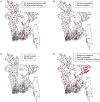Human Exposure to Bats, Rodents and Monkeys in Bangladesh
- PMID: 37099204
- PMCID: PMC10131556
- DOI: 10.1007/s10393-023-01628-9
Human Exposure to Bats, Rodents and Monkeys in Bangladesh
Abstract
Bats, rodents and monkeys are reservoirs for emerging zoonotic infections. We sought to describe the frequency of human exposure to these animals and the seasonal and geographic variation of these exposures in Bangladesh. During 2013-2016, we conducted a cross-sectional survey in a nationally representative sample of 10,002 households from 1001 randomly selected communities. We interviewed household members about exposures to bats, rodents and monkeys, including a key human-bat interface-raw date palm sap consumption. Respondents reported observing rodents (90%), bats (52%) and monkeys (2%) in or around their households, although fewer reported direct contact. The presence of monkeys around the household was reported more often in Sylhet division (7%) compared to other divisions. Households in Khulna (17%) and Rajshahi (13%) were more likely to report drinking date palm sap than in other divisions (1.5-5.6%). Date palm sap was mostly consumed during winter with higher frequencies in January (16%) and February (12%) than in other months (0-5.6%). There was a decreasing trend in drinking sap over the three years. Overall, we observed substantial geographic and seasonal patterns in human exposure to animals that could be sources of zoonotic disease. These findings could facilitate targeting emerging zoonoses surveillance, research and prevention efforts to areas and seasons with the highest levels of exposure.
Keywords: Bangladesh; Bat; Human exposure; Monkey; Rodent.
© 2023. EcoHealth Alliance.
Figures




References
-
- Annett HE, Amin BM, Lele GK (1913) The date sugar industry in Bengal: an investigation into its chemistry and agriculture. Imperial Department of Agriculture in India
Publication types
MeSH terms
Grants and funding
LinkOut - more resources
Full Text Sources
Miscellaneous

